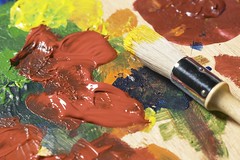 As designers we each have our own thought processes we work through with each new project we produce. We might have a great idea, but as the design progresses we might realize that we don't have the ability to execute it successfully and/or professionally. Conversely, we might have a vague idea of something we want to create and end up with something truly extraordinary.
As designers we each have our own thought processes we work through with each new project we produce. We might have a great idea, but as the design progresses we might realize that we don't have the ability to execute it successfully and/or professionally. Conversely, we might have a vague idea of something we want to create and end up with something truly extraordinary.As modern artists working in a digital medium, I think that we often place more importance on the end result without appreciating the process that got us there. As graphic designers using state-of-the-art software, we can easily backtrack, fix or change our creations at any point while creating a work.
 Have you ever painted a still life? I have. It took months, and I absolutely hated it. About a year ago I took a beginning painting class for my fine art minor. I gained an appreciation for the artistic process that I had never before considered. I also learned it's important to plan ahead and make decisions with precision and care when creating a work of art.
Have you ever painted a still life? I have. It took months, and I absolutely hated it. About a year ago I took a beginning painting class for my fine art minor. I gained an appreciation for the artistic process that I had never before considered. I also learned it's important to plan ahead and make decisions with precision and care when creating a work of art. my pitiful attempt at a still life>>>
While painting a traditional still life, the painter progresses in layers. The first layer is a monochromatic yet completely detailed painting. Then the painter adds layers of glazes that have painted tints. Over and over. The average still life has about 10 layers of glaze, which is what gives (good) paintings their realistic depth and precise details.
Typically, painters wanting to make changes have to wait for the paint to dry before correcting any mistakes. Photographers have to know how to expose their film in certain lighting, knowing they can only make limited corrections while developing the film in the darkroom. Sculptors, well, if they take away too much, good luck fixing that.
My painting professor, Nathan Sullivan, obviously understood the process. You can't miss his work; it's amazing.
In the end, I really didn't like how my still life turned out. I have no desire to ever display it anywhere (other than here, ha). However, the experience pointed out that our generation is impatient and wants instant gratification, even when it comes to creating art. I must admit that I am no different, which is something I need to keep in mind as I create my magazine designs.
In the end, graphic designers have it easy. We should appreciate the ease of our medium and take the time to fully contemplate our artistic process.

No comments:
Post a Comment